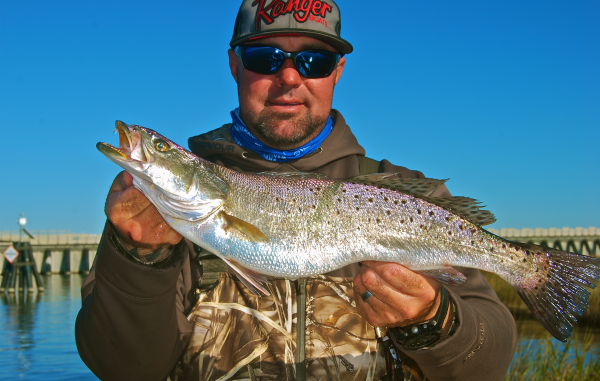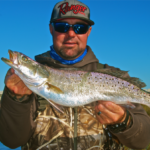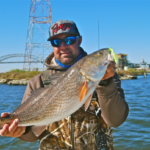
Lamy offers tips for the Hot Water Canal, the Great Wall and the MRGO
In “A Christmas Story” (which we’re all about to see hundreds of times between Thanksgiving Day and Dec. 25,) Ralphie waits and waits for the arrival of his Little Orphan Annie Secret Society decoder ring.
The first code he cracks is a sales pitch for Ovaltine, and Ralphie gets a rude welcome to the world of marketing at the tender age of 9.
Capt. Bubby Lamy, with In & Out Charters in Slidell, doesn’t have a Secret Society ring, but he has to ‘crack the code’ every day he pursues speckled trout in his 23-foot Ranger bay boat at Chalmette wintertime hotspots like the Hot Water Canal, the Great Wall and the rocks along the Mississippi River Gulf Outlet (MRGO.)
Water temperatures on a recent trip ranged from a chilly 53 degrees in the MRGO to a relatively balmy 64 near the Hot Water Canal.
But that’s just one variable Lamy considers when trying to figure out the daily trout bite.
“The water temperature varies throughout the day. They can start deep, but at what temperature are they at 17 feet? When do they hit 12 feet? How are they sitting on the ledge,” Lamy asked. “Do they want the lure from deepwater working up, or are they facing the other direction?
“You’ve got to put yourself in those situations to help figure it out.”
When he’s not Carolina-rigging live shrimp, Lamy’s artificial lure color preference will change over the winter. He is a big fan of Matrix Shad and Matrix Vortex Shad, especially in purple haze and shrimp cocktail — but his presentation speed is consistent when the water is cold.
Consistently slow.
“You’re definitely working your lure slower,” Lamy said. “You’re trying to keep pretty consistent contact with the bottom. Those fish are cold, just like us. When we’re really cold, we don’t have the agility to move real fast.
“So you want to focus on slowing your presentation down. Kind of dribble it and give the fish reaction time to say, ‘Oh, I see it, and now I can eat it.’ Don’t work it so fast that you’re pulling it away.”
Lamy recommends moving to a heavier jighead to more effectively work the wintertime pattern.
“Lots of times when it gets real cold like this, I’ll switch to a ½-ounce jighead because you’re almost forced to slow it down,” he said. “You’re not going to move a ½-ounce jighead as fast as you’re going to move a ¼- or ⅜-ounce jighead.
“It’s going to slow down simply because it’s more weight.”
Another key he uses to crack the code is his own daily log book, which he records after each and every trip.
“The number one thing I would suggest to any fisherman is to record where you were, what you caught, the tidal conditions and weather conditions,” he said. “Those fish are going to come back to that same area year-in and year-out, whether it’s a a week or two early or a week or two late.
“So last year, you can see in the second week of November you caught fish in a certain area, say Chalmette. So now you can come out and go to that area and that’s what you’re going to do: Try and crack the code in lots of different ways. Bouncing it up the ledge, bouncing it off the ledge, hitting the rocks closer to shore, slow dribbling it off the rocks or hard popping it off the rocks.
“Until you get that first strike, pay attention to which way they want it, and then you can try to repeat the pattern.”
So far this year, after a couple of pretty strong cold fronts for mid-November, he said it’s been more of a subtle bite.
“More times than not in the past few days, it’s been pop-pop-pop, then let it fall and hit the bottom,” he said. “Then I let it sit, and before I ever raise it again, they’re grabbing it.”
Not surprisingly, heat is a big factor in fishing the chilly wintertime pattern — and not just the higher water temperatures affecting the area immediately around the Hot Water Canal.
“The Wall is concrete. The sun heats that concrete faster — the same things happens on the bridge in Lake Pontchartrain. It heats it faster so the water temperature immediately next to The Wall is warmer,” he said. “That’s the same reason we fish the rocks — the water temperature next to the rocks is going to be warmer than the water out in the middle of Lake Borgne.”
That relates to another important wintertime tip which most fishermen would probably enthusiastically embrace.
“You don’t have to leave at the crack of dawn,” Lamy said. “You can leave a little later and let the sun get up and heat it up a little bit.
“I think as the day progresses the bite just gets better until the temperature starts dropping again.”




